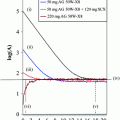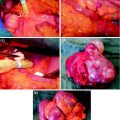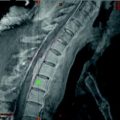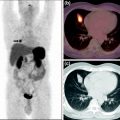Fig. 1
Prevalence of rare metastases at the Bad Berka theranostics center
2.1 Cardiac Metastases
Cardiac metastases are rare in all primary neoplasms (Bussani et al. 2007). Although secondary cardiac tumors are rare, their reported incidence is between 1.6 and 20.6% (Rafajlovski et al. 2005). The commonest tumors related with cardiac metastasis are melanoma, lung, breast, lymphoreticular malignancies, and mediastinal primary tumors (Smith 1986). Neoplastic cells may disseminate to the heart by lymphatic or hematogenous pathways, local spread, or transvenous extension. Retrograde spread through lymphatic channels is the most common route of extension. Since most of the neoplastic cells are filtered by the hepatic and pulmonary microcirculation, hematogenous metastases to the heart are associated with metastases to these organs as well (Makhija et al. 2009). We detected 35 cases of cardiac metastasis (prevalence of 0.83%) (Fig. 2).


Fig. 2
A 70-year-old man with diagnosis of highly differentiated neuroendocrine carcinoma of unknown origin. The 68Ga-DOTATATE PET/CT (PET, CT, and fused) transverse image shows a somatostatin receptor (SSTR)-positive lesion near the apex of the heart
2.2 Breast Metastases
Metastases to the breast are also uncommon, fewer than 2% of all breast tumors. Of all metastatic tumors in the breast, most arise from contralateral breast primaries. Other reported primary solid tumors are melanoma, lung, gastric, renal cancers, and a few cases of neuroendocrine tumors (Geyer et al. 2010). In our series we detected 21 cases of breast metastasis (prevalence of 0.49%) (Fig. 3).


Fig. 3
A 49-year-old woman with diagnosis of neuroendocrine tumor of the pancreatic tail. The 68Ga-DOTATATE PET/CT (PET, CT, and fused) transverse image shows a SSTR-positive solid lesion compatible with right breast metastasis
2.3 Retro-Orbital
Ocular metastases from carcinoid tumors are considered rare. Isidori et al. (2002) identified 6 of 40 patients (15%) with ocular metastases by [111In]octreotide. We detected nine cases of retro-orbital metastasis (prevalence of 0.21%) (Fig. 4).
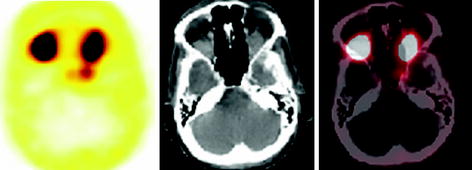

Fig. 4
A 66-year-old man with diagnosis of well-differentiated rectal neuroendocrine tumor. The 68Ga-DOTATATE PET/CT (PET, CT, and fused) transverse image shows bilateral retro-orbital SSTR-positive metastases (SUVmax 15.2)
2.4 Soft Tissue
Soft tissue has been also reported as a possible location for uncommon metastasis of NETs. We detected eight cases of skin metastasis (prevalence of 0.19%) and four cases of intramuscular metastasis (prevalence of 0.09%) (Fig. 5).

